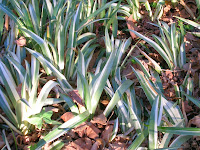 Eomecon chinonantha, Snow Poppy
Eomecon chinonantha, Snow Poppy
Many garden plants are given a common or Cultivar name using the word "snow".The following are a few that I grow.
Flowering right now is the perennial from China the Snow Poppy. The flowers are in groups of 3 or 5 on stiff upright stems to about 15cm. The leaves are round with a slight gloss to them especially during the cooler months . In summer the leaves are less appealing and are often burnt around the edges on hot days. This is a great perennial to grow in difficult sites under trees.It spreads out by creeping rhizomes and may need some containing in overly favourable sites. Cut root pieces, which have a colour similar to turmeric, strike readily.To compliment it, it would be worth teaming it with Iris japonica 'Variegata' which likes similar growing conditions.This has white and grey green striped leaves.

Iris japonica 'Variegata', Japanese Iris
If you like to see "snow" in summer it is hard to beat the magnificent Japanese water Iris: Iris ensata 'Driven Snow' It flowers for many weeks with a succession of delicate flowers. Right now it has gone to ground and is just showing some tiny leaves.

Iris ensata 'Driven Snow'
The native paperbark tree Melaleuca linariifolia is usually given the common name of Snow-in-Summer because of the masses of fluffy white flowers which blanket the canopy. I grow this on the nature strip as it only reaches about 5 metres and has a neat rounded habit. There is also a dwarf compact Cultivar of this tree called 'Snowstorm' which only grows to about 1.5metres.Finally ,it is hard to resist growing the annual Snow-on-the-Mountain, Euphorbia marginata .Sowing the seed direct where it is to grow in early spring ,it is a hardy and not in need of any special soil and has low water requirements.
 Euphorbia marginata, Snow-on-the-Mountain
Euphorbia marginata, Snow-on-the-Mountain






